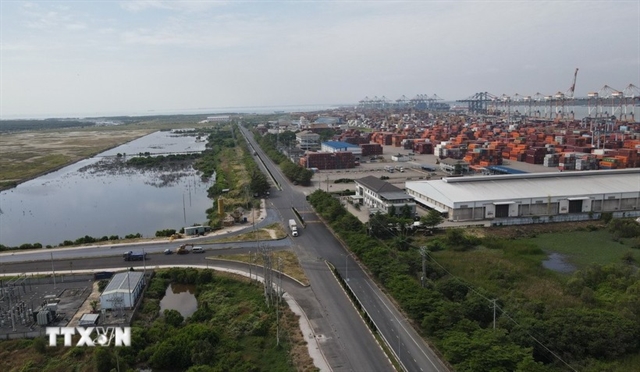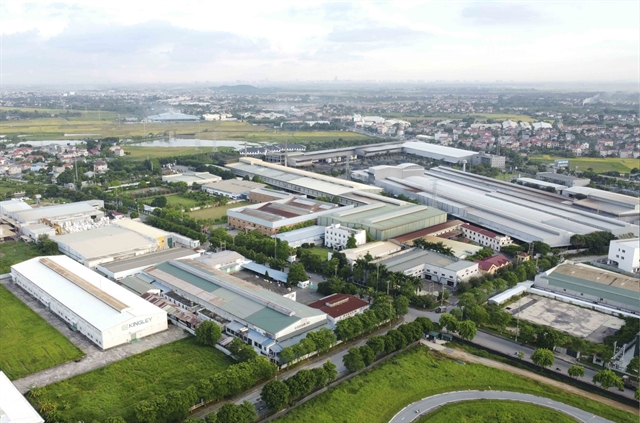 Economy
Economy

 |
| ue to strong demand from various sectors, average occupancy rates of tier-1 markets in the northern region reached 83.2 per cent as of Q4 2022. — VNA/VNS Photo |
HÀ NỘI — CBRE Vietnam has reported that Việt Nam's industrial real estate sector is poised for a prosperous year in 2023 due to a surge in demand.
This upswing is largely attributed to an ongoing production shift and China-plus One strategy of manufacturers. The rental prices of industrial park lands in tier-1 markets are expected to rise by 5-10 per cent, fueled by robust demand.
In addition, the CBRE Market Outlook 2023, released on February 17, revealed that in 2022, net absorption in tier-2 markets witnessed a substantial increase, further confirming the continuation of this trend in the coming years.
Throughout 2022, northern industrial markets sustained a positive performance. By the end of 2022, the industrial land supply of tier-1 markets in the North reached 10,291 ha, up 8 per cent yearly. Bắc Ninh and Hưng Yên are two provinces that had new industrial parks coming into operation.
Due to strong demand from various sectors, average occupancy rates of tier-1 markets in the northern region reached 83.2 per cent as of Q4 2022. The net absorption of 2022 was at 519 ha, similar to 2022’s net absorption. The most active tenants in the North include electronics, solar-energy, automobile manufacturers and ready-built warehouse and ready-built factory developers.
The average industrial land rental rates of tier-1 markets in the North stayed at US$120 per sq.m, remaining terms up by 11 per cent compared to 2021.
During the year, selected industrial parks in Bắc Ninh and Hưng Yên significantly increased the rental rates as occupancy improved, leading to the highest market rental growth over the past five years when the rental growth typically ranged between 6-7 per cent per annum.
Meanwhile, in the South, the average rent of tier-1 markets increased by 8-13 per cent year-on-year and reached $166 per sq.m remaining terms by the end of 2022, about 38 per cent higher than those of the North.
For the ready-built warehouse (RBW) and ready-built factory (RBF), the market witnessed strong growth in supply in the past year.
The total supply of RBW and RBF in the tier-1 markets in the North increased by 19 per cent and 26 per cent year on year, respectively, reaching 1.5 million sq.m of RBW and 1.7 million sqm of RBF.
Due to the rapid increase in new supply, the occupancy rate of RBW decreased by 7 per cent year on year to 87 per cent, while the average occupancy rate of RBF stood at 84 per cent, down 3.5 percentage points.
However, due to good demand from industries such as automobiles and components, logistics, and electronics, absorption rates of both segments recorded year-on-year growth, reaching 118,000 sqm for RBW and 242,000 sq.m for RBF, totalling up by nearly 50 per cent year on year.
The average rent of RBF and RBW of tier-1 markets in the North reached $4.7 per sq.m per month, up by 2 per cent yearly.
The occupancy rate of industrial parks nationwide has reached about 80 per cent, of which this rate in the southern provinces and cities reaches over 85 per cent of the total area.
Especially, Bình Dương Province is the locality with the highest occupancy rate of industrial parks. Twenty-nine industrial parks in operation in this province have an occupancy rate of over 95 per cent.
Besides that, Phùng Thị Thanh Loan, senior manager of CBRE Vietnam, said: “In the northern industrial market, big transactions have been mainly concentrated in the tier-2 market. This trend is expected to continue in the coming years.”
The tier-1 markets in the North include Hà Nội, Hải Phòng, Hải Dương, Hưng Yên, and Bắc Ninh. The tier-2 markets include Thái Nguyên, Vĩnh Phúc, Bắc Giang, Quảng Ninh, Thái Bình and Hà Nam.
However, this situation is the opposite in the South. The top 10 most prominent transactions in the southern industrial market were mainly carried out in the tier-1 markets, including HCM City, Bình Dương, Long An and Đồng Nai. The tier-2 markets in the South include Bình Thuận, Bà Rịa-Vũng Tàu, Bình Phước and Tây Ninh.
Within three years, the industrial land supply will increase by more than 3,500 ha for tier-1 markets. Due to the improvement in the infrastructure system, industrial markets in the North are anticipated to expand to tier-2 markets such as Thái Bình and Quảng Ninh.
Lê Trọng Hiếu, senior director, head of Advisory and Transaction Services at CBRE Vietnam, said: “The supply in both markets will continue to increase, both in terms of industrial land and warehouses."
"However, the price will not increase much. Especially, industrial land rental rates will remain moderate to keep competitiveness. Meanwhile, the supply of new warehouses will also enter the market. Therefore, the price will also have the same competition, at about US$4.70-4.80 per sqm per month.”
Nguyễn Văn Đính, vice chairman of Việt Nam Real Estate Association, said in 2022, the industrial real estate segment attracted investment activities. This segment was forecast to develop strongly this year.
Việt Nam's industrial real estate segment has many favourable factors in attracting foreign investment, according to Đính. The transport infrastructure in the South is developed to connect tier-1 markets and between the tier-1 and tier-2 markets.
They involve the HCM City Expressway-Trung Lương-Mỹ Thuận completed in 2022 and projects in the future such as Dầu Giây-Phan Thiết Expressway, Mỹ Thuận-Cần Thơ-Bạc Liêu Expressway, and Nhơn Trạch Bridge. — VNS




